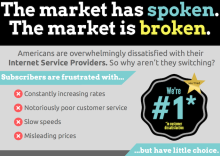Infographic: The Market Has Spoken. The Market Is Broken.
“Monopoly” may be a fun family night activity, but if you live in a place where you have little or no choice for Internet access, it’s not fun and it’s not a game.
According to FCC data, most families don’t have a choice in Internet access providers, especially providers they like. Nevertheless, the biggest companies keep reporting increasing revenues every year. People aren’t happy with the service they’re receiving, but companies like AT&T and Comcast continue to thrive. What’s going on?
In a recent State Scoop piece, Christopher wrote:
[T]he market is not providing a check to AT&T or Comcast power. They are effectively monopolies — and as we just saw — can translate their market power into political power to wipe out regulations they find annoying.
At the Institute for Local Self-Reliance, where we work to support local economies, this broken market is a major problem. Cable monopolies are bad for local businesses, which become less competitive from paying too much for unreliable Internet access. Communities cannot thrive without high quality Internet access today.
We created this infographic to present the evidence showing that the market is broken. This resource also discusses why creating more competition in the current market is such a challenge. An effective way to overcome this broken market, however, is to consider what hundreds of local communities are already doing - investing in publicly owned Internet infrastructure. Our infographic offers a few examples of different models, each chosen to suit the communities they serve.
Get a larger version of the infographic here.

Get a larger version of the infographic here.
Kudos to intern Kate Svitavsky who created the infographic.
Stay up to date on community networks with our newsletter.



